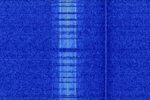160.282.000 in Berlin, Germany
From Signal Identification Wiki
Additional Samples[edit]
Additional Images[edit]
Signal Analysis[edit]
From the waterfall display in the images, we can infer several characteristics of the observed signal:
- Consistent Patterning
- The signal exhibits a regular, repeating structure with distinct blocks, suggesting a digital mode of transmission rather than voice communication.
- Location Proximity
- The signal is noted to be found close to railways, which may imply its use in railroad communication systems that often employ digital signaling.
- Potential Modulation
- The patterns suggest the possibility of PSKPhase-Shift Keying (Phase Shift Keying) modulation, a common method for digital communications, including rail signaling.
- Frequency Range
- Operating around 160 MHzMegaHertz (MHz) 10^6 Hz, the signal falls within a frequency band commonly used for various communication services, potentially including those for transportation.
- Purpose
- The signal's proximity to railway infrastructure and the frequency used hint at its role in railway communications or control systems.
In summary, this signal likely represents a digital communication link, possibly associated with railway operations, indicated by its structured patterning, location, and the frequency range. Future analysis would benefit from an I/Q file to confirm the exact modulation scheme and to decode the transmission.
- Further Analysis
- A detailed examination including the modulation scheme, bit rate, and encoded data is necessary for comprehensive understanding. Such analysis requires an I/Q file, which captures the amplitude and phase information essential for this purpose. However, the absence of an I/Q file limits the potential for in-depth analysis based solely on the visual indicators presented.
